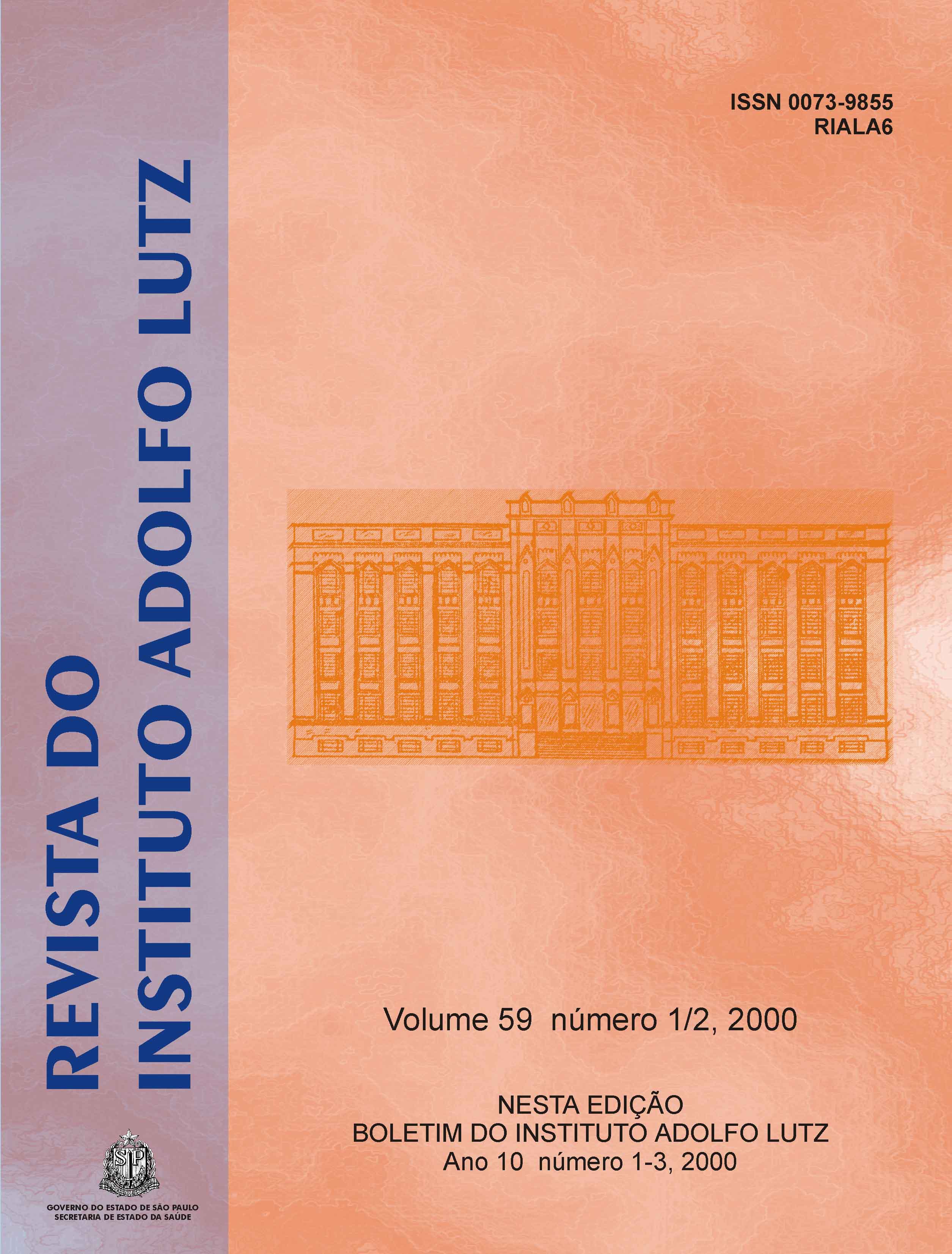Abstract
Between September 11 and 20, 1996, an outbreak of bacteremia occurred in patients undergoing hemodialysis at one dialysis center in Campinas, São Paulo, Brazil. Water and dialysate samples as well as blood samples from patients with bacteremia were collected for bacteriological analysis. All Pseudomonas
aeruginosa strains were serotyped and pyocin-typed. P. aeruginosa strains belonging to the same serotype (O15) and pyocin type (P10) were submitted to antimicrobial susceptibility testing and to ribotyping using two restriction enzymes, EcoRI and BamHI. The high concentrations of bacteria detected in all hemodialyzers
and their heavy rate of contamination (86.7%) by Pseudomonas aeruginosa or Burkholderia cepacia showed that this dialysis center was operating in inadequate conditions. One strain of P. aeruginosa isolated from hemodialyzer and the strains recovered from blood cultures of patients showed similar phenotypical and genetic traits which suggest a common source of infection in this oubreak. We report the potential risk for patients undergoing hemodialysis to acquire infections due to the inadequate practice of reusing disposable dialyzers during the reprocessing procedures.
References
1. American Public Health Association. Standard Methods for the Examination of Water and Wastewater. 19th ed. Washington: APHA; 1995. p. 9-31 r 9-53.
2. Association for the Advancement of Medical Instrumentation. American national standard for hemodialyis systems. In: AAMI Standards and Recommended Practices. Volume 3: Dialysis. Arlington,VA: Association for the Advancement of Medical Instrumentation; 1990. P. 27-58.
3. Arduino, M.J. et al. Comparison of microbiologic assay methods for hemodialysis fluids. J. Clin. Microbiol., 29: 592-594, 1991.
4. Bodey, G.P. et al. Infections caused by Pseudomonas aeruginosa. Rev. Infect. Dis., 5: 279-313, 1983.
5. Beck-Sague, C.M. et al. Outbreak of Gram-negative bacteremia and pyrogenic reactions in a hemodialysis center. Am. J. Nephrol., 10: 397-403, 1990.
6. Blanc, D.S. et al. Ribotyping of Pseudomonas aeruginosa: Discriminatory power and usefulness as a tool for epidemiological studies. J. Clin. Microbiol., 31: 71-77,1993.
7. British Pharmacopœia. London: International Edition; 1993. p. 935-936.
8. Brenner, D.J. et al. Escherichia vulneris: a new species of Enterobacteriacae associated with human wounds. J. Clin. Microbiol., 15: 1133-1146, 1982.
9. Carson, L.A. et al. Prevalence of nontuberculous Mycobacteria in water supplies of hemodialysis centers. Appl. Microbiol., 54: 3122-3125, 1988.
10. Costerton, J.W. The etiology persistence of cryptic bacterial infections: A hypothesis. Rev. Infect. Dis., 6: S608- S616, 1984.
11. Favero, M.S. et al. Factors that influence microbial contamination of fluids associated with hemodialysis machines. Appl. Microbiol., 28: 882-830, 1974.
12. Favero, M.S. et al. Microbial contamination of renal dialysis systems and associated health risks. Trans. Am. Soc. Artif. Int. Organs., 20: 175-183, 1974.
13. Favero, M.S. Health hazards associated with high levels of gram-negative bacteria in hemodialysis systems. In: AAMI Standards and Recommended Practices. Volume 3:Dialysis. Arlington: VA:Association for the Advancement of Medical Instrumentation; 1990. P. 81-101.
14. Fyfe, J.M.; Harris, G.; Govan, J.R.W. Revised pyocin typing method for Pseudomonas aeruginosa. J. Clin. Microbiol., 20: 47-50, 1984.
15. Gordon, S.M. et al. Pyrogenic reactions associated with the reuse of disposable hollow-fiber hemodialysers. J. Amer. Med. Ass. 260: 2077-2081, 1988.
16. Grattard, F. et al. Differentiation of Pseudomonas aeruginosa strains by ribotyping: high discriminatory power by using a single restriction endonuclease. J. Med. Microbiol., 40: 275-281, 1994.
17. Grundmann, H. et al. Pseudomonas aeruginosa in a neonatal intensive care unit: reservoirs and ecology of the nosocomial pathogen. J. Infect. Dis., 168: 943-947, 1993.
18. Gruner, E. et al. Ribotyping of Pseudomonas aeruginosa strains isolated from surgical intensive care patients. J. Infect. Dis., 167:1216-1220, 1993.
19. Instituto Adolfo Lutz. Manual de Normas Analíticas do Instituto Adolfo Lutz: Métodos Químicos e Físicos para Análise de Alimentos. São Paulo: Instituto Adolfo Lutz; 1982. P. 533.
20. Kidd, E.E. Bacterial contamination of dialysis fluid of artificial kidney. Brit. Med. J., 1: 880-882, 1964.
21. Kuikka, A.; Valtonen, V.V. Factors associated with improved outcome of Pseudomonas aeruginosa bacteremia in a Finnish University Hospital. Eur. J. Clin. Microbiol. Infect.Dis., 17: 701-708, 1998.
22. Lanyi, B.; Bergan, T. Serological characterization of Pseudomonas aeruginosa. Methods Microbiol., 10: 93-168, 1978.
23. Lowry, P.W. et al. Mycobacterium chelonae infection among patients receiving high-flux dialysis in a hemodialysis clinic in California. J. Infect. Dis., 161: 85-90, 1990.
24. Maki, D.G. Nosocomial bacteremia. An epidemiological overview. Am. J. Med., 70:719-732, 1981.
25. Ministério da Saúde – Portaria MS – GM 82/2.000 de 03 de Janeiro de 2.000 – Diário Oficial da União, Brasília, 08 de Fevereiro de 2.000 – Seção 1, p.13-16
26. National Committee for Clinical Laboratory Standards. Performance standards for antimicrobial susceptibility testing. 6.ed.. Villanova: Appproved Standard. M2-A6; 1997.
27. Palleroni, N.J. Genus I – Pseudomonas. In: Bergey’s Manual of systematic bacteriology.Baltimore: Willliam & Wilkins; 1986. p. 141-199.
28. Picard, B. et al. Genetic heterogeneity of Pseudomonas aeruginosa clinical isolates revealed by esterase electrophoretic polymorphism and restriction fragment-length polymorphism of the ribosomal RNA gene region.J. Med. Microbiol., 40: 313-322, 1994.
29. Popovic, T.; Bopp, C.A.; Wachsmuth, K. Epidemiological application of a standardized ribotype scheme for Vibrio cholerae O1. J. Clin. Micrcobiol., 31: 2474-2482, 1993.
30. Romling, U. et al. A major Pseudomonas aeruginosa clone common to patients and aquatic habitats. Appl. Environ. Microbiol., 60: 1734-1738, 1994.

This work is licensed under a Creative Commons Attribution 4.0 International License.
Copyright (c) 2000 Revista do Instituto Adolfo Lutz
